Would you believe me if I said that embroidery can be strenuous work? Most people wouldn’t! But it can be – depending on the type of embroidery.
Lately, I’ve been working on some fairly intense embroidery projects. The kind that require concentration. The kind that require space in my workroom. The kind that are not transportable. I can’t sit and chat with friends or watch a movie and do them. In fact, when I’m working on them, I become rather anti-social.
But I like embroidery to be a social thing. I like to embroider around people. If I want to watch a movie of an evening with friends and family, I like to have something to do with my hands. I like to grab a project and take it with me on long car rides, or if I’m going somewhere that will inevitably require a wait.
For these situations, I usually have a few projects set up that I call grab & go projects, or “social” embroidery projects. Most of them are casual embroidery items that I give away.
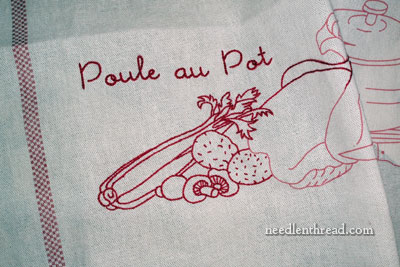
After going a couple months without a “social” embroidery project, I thought it was high time to get one started. I settled on this towel from Rouge du Rhin, a French needlework company. Why this particular project? Well, I didn’t have to do any set-up work on it – it’s a coarse weave cotton towel with the design already stamped on it. It’s also a good excuse to “test stitch” in case I want to mention this product on Needle ‘n Thread.
And I do.
And so I am.
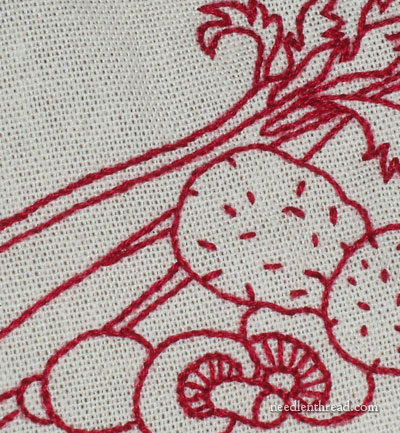
Rouge du Rhin has this new series of stamped towels out on the market, and they’re just getting into the US through sources like The French Needle.
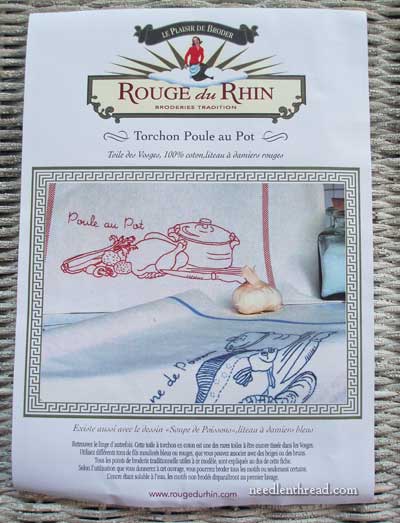
The particular towel I’m working on is redwork, with the design stamped in red, and featuring a naked chicken, some veggies, and a pot – chicken soup, pretty much. The other towel in the series is worked in blue, and it features fishy things and a pot. “Soupe de Poissons” might be considered by your non-Francophile friends as something a bit dodgy, but in fact, it’s just fish soup.
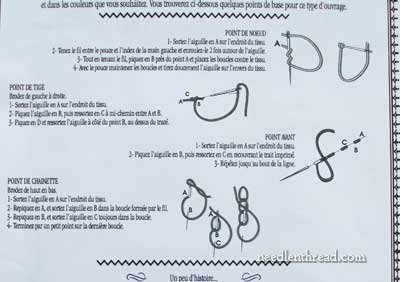
Each towel is sold separately, and it comes with a label sheet that has stitch instructions on the back of it. They’re written in French, but the diagrams are clear enough for anyone to follow, whether French-speaking or not.
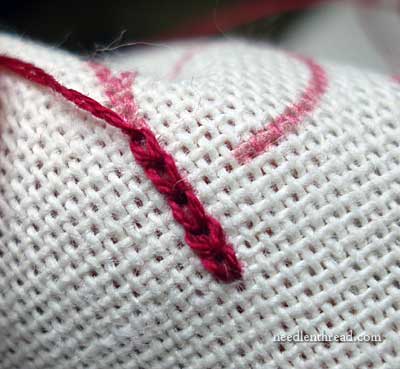
You can see that the cotton fabric is rather coarse, with a thick, somewhat open weave. These are casual, “rough” towels, not to be confused with these fine linen glass towels from France that I’ve written about before.
The printed lines are also rather thick for design lines, but not thick enough that they can’t be covered easily with stitches worked from two strands of floss. The design lines are very easy to see, which is good when you’re working in less than ideal lighting conditions. The towel, unwashed, is easy to stitch in hand, without a hoop.
Along the selvedge of the towel (running length-wise a bit in from both edge) is a woven band of red in a checkered pattern. The short edges (perpendicular to the selvedge) are unfinished, so after the stitching is done, each side has to be hemmed. I may play around with the hem a little bit, to see if I can come up with a alternative to a plain hem.
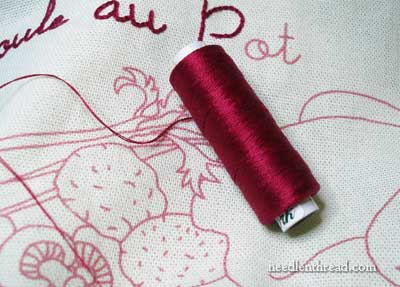
I’m stitching the towel with a multi-work, two-stranded cotton thread from Cosmo.
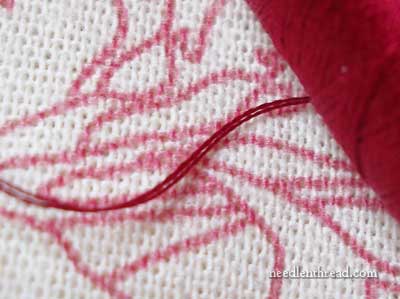
This thread comes off the spool in two strands, ready for stitching. It’s a good thread for redwork, and there’s a whole lot of it on that spool.

So this is my social chicken project. It’s definitely ‘grab & go’ style – just the towel, one spool of thread, a needle, and scissors are all you need to work it. No hoop. No multiple skeins of floss. Easy-peasy when it comes to stitching on the go, or when chatting with friends.
Once I get the stitching done on this, I’ll wash it to see how the towel & thread react to laundering. I’m looking forward to that part! It may all go to pot (oh, ha ha) in the wash, but it may not. We shall see!
Rouge du Rhin has another line of surface embroidery-related goods out, but I’ll have to show you those another time!
Later this week, I’m doing a book give-away, so look for it. Also coming up – a photo tutorial great for beginners. I’m also working on some new video footage (a fun stitch!). So it promises to be a busy week. Hope yours is terrific!







A great project to take along. A simple crocheted edging would be nice. After it is complete, it would make a nice gift with a bottle of wine and some cheese. Of course, most anything would be nice with some wine and cheese!
Deb
Hi, All! Thanks for your comments!
Yes, Deb – the wine and cheese idea is super! That’s generally what I do for gifts. I put together a basket that I line with an embroidered towel (draping the embroidery over the outside edge of the basket) and then I fill the basket with the gift items. It always makes a ‘bought’ gift more personal, and not entirely ‘bought.’
~MC
I totally believe you. Especially when the work is complicated. Embroidery can be as simple as drawing with thread or it can feel as complicated as the Sistine Chapel. Your work is beautiful. This is a wonderful website. I look forward to reading and seeing much more.
I know what you mean about needing a social project. I’m going on vacation and taking with me a dress which has 14 bullion flowers that need to be embroidered which each flower having about 10 bullion knots, some smocking and a simple Christmas ornament. Oh, and some crocheting! I like to be prepared. There are supposed to be thunderstorms in Chicago today.
The towels are terribly cute, and I like Deb’s wine and cheese idea!
These are so pretty! I would love to make some of them for my kitchen – are they made to be used or ‘just for show’? My problem is, when I get pretty kitchen towels is that my husband is likely to wipe up blueberry juice with it or mustard that dripped on the floor 🙁 Yes, I’ve pointed it out – please use a rag, or a paper towel… but at the time, he just doesn’t remember. I’d have to make this towel and then frame it for decorating my kitchen!
I’m reading Your blog for a few years and I love the information about crewel, goldwork and, especially, ecclesiastical embroidery.
This towel reminds me traditional Polish makatka. It’s a kind of towel which is only for decoration. Example you see here: http://wiano.eu/view/332 (I know it’s a shop, but I didnt’t found the better one).
It’s usually a piece of thin, white cotton or linen with blue or red embroidery. Typical is some sentences with some portraits of housewife f.e. In this picture senetnce means: “Good wife is proud of cooking, what her husband likes”.
Dear Mary
What a good idea cheese and wine yummy! I’m going to Turkey at the end of September for a relaxing yoga week and I shall be taking embroidery with me. I don’t know if you remember I asked you about fabric for Christmas cards and you advised using felt I’ve got the felt so I will take that along and stitch Christmas cards while I am there no hoop needed.
Regards Anita
I’m wondering how to start and end knots on table linens without there being a big knot on the back. Do you have a tutorial for that? I learn so much from your newsletters! Thank you!
Hi, Sharyn – I sure do have a tutorial for that! It’s right here: https://needlenthread.wpengine.com/2008/09/starting-your-thread-anchor-stitches-on.html You can use several farther spaced tiny backstitches, too, following the same general concept that’s in the tutorial. This is the only way I start a thread on this type of project. For ending threads, I weave them into the stitches on the back, and “hitch” the thread about halfway. Here’s a tutorial: https://needlenthread.wpengine.com/2008/10/ending-embroidery-thread-pull-it.html
Hope that helps!
~MC
Thank you, Mary. I’m going to print and trace a pattern today onto a dishcloth and try it out. I’ve been thinking of this for a while. Thank you so much!
Sharyn
Hi Mary, I like having a small project that I can pick up anytime and the towel are really sweet.
The fishy one really interest me,,,hummm I will go see this French site. Thanks.
France
Hi Mary,
I love the idea of having an easy “social chicken” also. Another idea I thought was great, during a retreat, I saw a woman who had stitched up the firt part of a large part of her project with the first leg of the cross stitches prior to the social event and then just had to finish the crosses while we gabbed. No missing stitches or miscounting. However, you do have to do some concentrative homework before the social event.
I love doing projects like these: simple redwork, or linedrawing embroidery. I often find designs in my children’s colouring books.
I know exactly what you mean about both the social aspect and the strenuous work involved – thankfully not at the same time. People are always interested in what you are doing and I’ve struck up many an interesting conversations with strangers over my work.
What’s the best way to wash these cloths? I’d be afraid of the stitching coming undone. Can it go in the washing machine at a gentle cycle?
Hi, Audrey – I haven’t thrown it in the laundry yet (because it’s not quite finished) but I will! And as soon as I’ve sent it through the wash, I’ll let you know how it turns out. I figure this type of towel should be able to withstand regular laundry. I’m not worried about the stitching coming undone. If you start and end your threads correctly, that should never be a problem, but I am wondering how the whole towel will stand up to the laundry (shrinkage, etc….) I’ll let you know! ~MC
Hi Mary,
I just finished a redwork embroidered pillow case. I used silk floss and white linen fabric which I think may not have been the best choice. When I washed the pillow case, the red floss bled all over the white linen. I searched your site for answers, since I love all your tutorials and always come here if I get stuck. That’s when I found this post. Is silk floss a no no for white linen? I’ve never had this happen before on anything else I’ve embroidered or smocked. I usually use DMC floss though. But I saw your post on all those gorgeous silk flosses you picked up recently and wanted to try some. I guess I should have tested first. I won’t make that mistake again. Thanks so much.
Hi, Angela – I often (almost always!) embroidery in silk on linen. It’s an excellent combination. But you’re right, you should test first if whatever you’re making is going to require washing. Not all silk is colorfast. In fact, many are not, especially the ones that are over-dyed, or hand-dyed, and so forth.
You might try running the pillow case under water for a while, to see if you can rinse out the extra dye. Then, in a pinch, try boiling the pillow case in a pot of water. You’ll probably lose some color from the thread, but you may be able to get all the excess color off the linen. If you’ve already dried the pillow case with the bleed on it, then it will be more difficult to get it out, but it doesn’t hurt to try!!
Whenever you’re going to make something that needs to be washed, and you’re working with threads that are red (and deep purples, too), it’s always a good idea to test the threads ahead of time, no matter what type of thread it is. This is even true of DMC. Today’s DMC is not prone to bleeding, but when it comes to reds, you never know – especially if you’re using an old skein of floss. It’s better to test before you stitch, than to find out afterwards!
I know you’re probably super frustrated over it, and I sympathize with you! We’ve all been there! I learned my lesson when a piece bled after months of stitching. I was using a good brand of silk, but one color I was using was about 10 years old, and their dyeing procedures have changed since then. The older skein bled, while the newer skeins I used didn’t. I’ve also had old DMC (red) bleed on me.
Let me know how you get on! You can also drop me an e-mail if you wish, if you have any specific questions or ideas about trying to get the color out of the linen.
MC
Thanks Mary! I don’t feel so bad now. At least my project only took a day or so – not months like you. Ouch! I did not dry the pillow case thinking I would try some remedy to fix it. I’ll definitely try your suggestions. Thanks again. I’ll let you know if it works.
Have been meandering about your website, not unlike the meandering gold thread (smiles). From the side edge of your site I had already written down the site for The French Needle, and later came upon this article. I love this project. Am giving french cooking lessons to one of my dance students, and this would make a nice gift for her upon completion of the lessons. Thanks for sharing. Since I am new to embroidery, my end result won’t quite match yours in quality, but I think she will love it just the same. Thanks Mary.